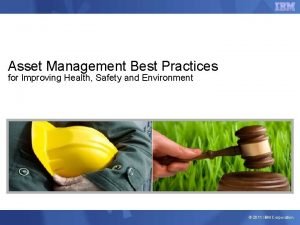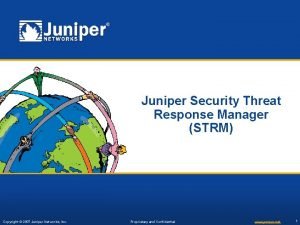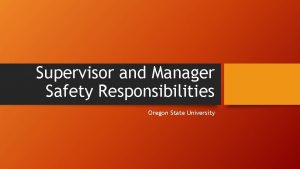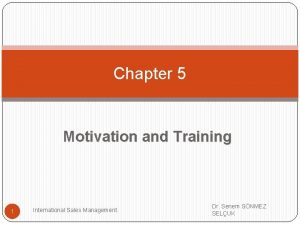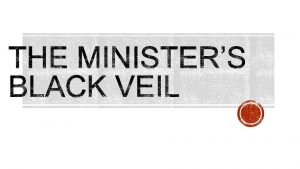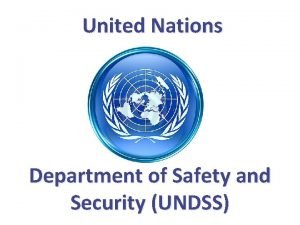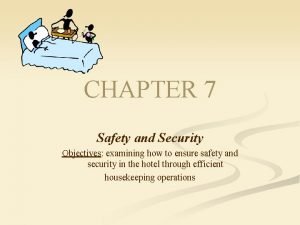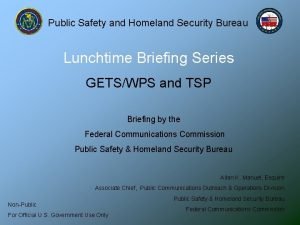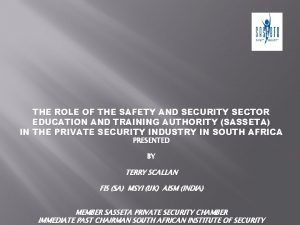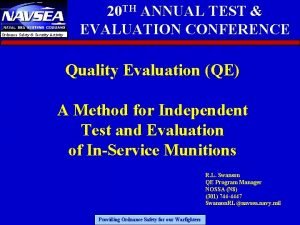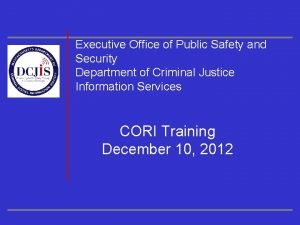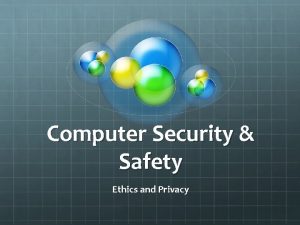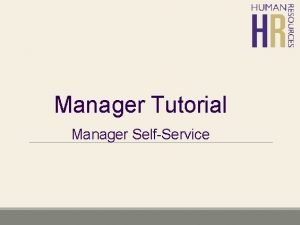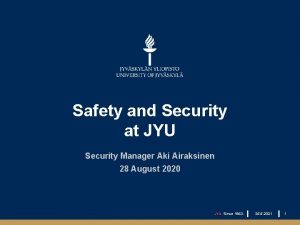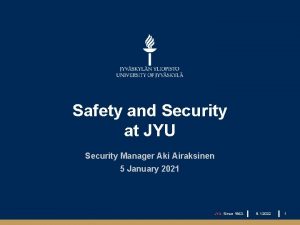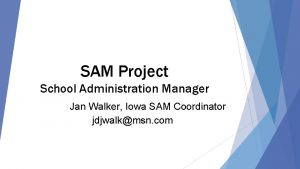Safety Security John Walker Manager Safety and Security







































- Slides: 39

Safety & Security John Walker Manager, Safety and Security O’Connor Hospital A Member of Daughters of Charity Health System

Pre-Test 1. A Code______ is activated when there is a bomb threat. a. Orange b. Yellow c. White 2. Scenario: A patient waiting to be seen in the Emergency Department becomes verbally abusive towards staff and visitors. The phone number to call to get help is either 333 or _____. a. 555 b. 515 c. 535 3. A Code _______ will be announced when there is a hostage situation and/or a person with a weapon. a. Gray b. Purple c. Silver 4. A Code Pink is announced overhead. Our first response should be_________. a. stay out of harms way b. clean the hazardous spill if we are trained c. monitor the nearest exit and stop suspicious persons carrying an infant or items that could contain an infant

Pre-Test, cont. 5. When a large chemical spill occurs, Code ________ is announced. a. Silver b. Yellow c. Orange 6. Code Triage _________ would be announced when a disaster has occurred outside the hospital. a. Internal b. External c. Lateral

Code Red - FIRE RESCUE Remove patients from immediate area ALARM Pull fire alarm and call 555 CONTAIN Close all doors in the area R. A. C. E. EXTINGUISH Attempt to extinguish fire using extinguisher

Code Red – FIRE, cont. How do you use a Fire Extinguisher? P. A. S. S. Pull the pin Aim the nozzle at the base of the fire Squeeze the handle Sweep the nozzle backwards and forwards

Code Blue Medical Emergency • The assigned Code team members will respond to the location • ACLS is initiated • All other personnel stay out of area unless assigned a specific task by a team member

Code White Medical Emergency Neonatal • The assigned Code team members will respond to the scene • Infant resuscitation is initiated per BLS, NRP or PALS standard of care • All other personnel stay out of area unless assigned a specific task by a team member

Code Pink Infant Abduction Hospital staff should watch all exits in their area Report suspicious activity by dialing “ 555” Stay in your location until the code is “all clear” Be on the look-out for someone carrying an infant or a backpack

Code Purple – Child Abduction (Pediatric) Hospital staff should watch all exits in their area Report suspicious activity by dialing “ 555” Stay in your location until the code is “all clear” The overhead page will state “Code Purple” followed by a number and then a letter M or F. (Code Purple 2 F indicates a 2 year old female)

Code Yellow - Bomb Threat • Call 555 • Do not touch or disturb the potential bomb • If a telephone threat try to determine where the bomb is located, when it’s going to explode, what it looks like, the name and sex of person calling • Refer to Safety section on the intranet and be ready to initiate search • DO NOT start search procedures until Security arrive • Code Yellow will not be paged overhead

Code Gray Security Assistance • Call 555 – State “Code Gray” followed by your name and location. • If you feel physically threatened • If you see someone arguing or fighting • If you feel intimidated

Code Silver Person with Weapon / Hostage • Seek cover/protection and warn others of the situation • Call “ 555” and report “Code Silver” and location (Include: The number of suspects and hostages and the type of weapon(s) involved)

Code Orange Hazardous Materials • • Call 555 Protect the scene Security will respond Locate Material Safety Data Sheet from the MSDS intranet connection • Be ready to evacuate if needed

Workplace Violence Prevention Definition of Violence in the workplace is defined as any incident of a threat or actual commission of an intentional harmful action against an associate by a co-worker, physician, patient or visitor on Hospital premises. Violence in the workplace also includes any such threat or actual commission of a harmful action if the threat or action is precipitated by something which occurred while the associate was working.

What Causes Violence? • Factors that can cause workplace violence to erupt include alcohol and drug abuse • Financial crises related to job loss, gambling, bad investments, or credit-card debt • Mental illnesses that have a wide variety of causes • Emotional strain and mental illness lessen a person's ability to cope with difficulties such as family or relationship problems or mistreatment (real or perceived) by others.

Warning Signs • Intimidating, harassing, bullying, belligerent, or other inappropriate and aggressive behavior • Numerous conflicts with customers, coworkers, or supervisors • Bringing a weapon to the workplace, making inappropriate references to guns, or making idle threats about using a weapon to harm someone

Warning Signs, cont. • Statements indicating desperation (over family, financial, and other personal problems) to the point of contemplating suicide • Direct or veiled threats of harm • Substance abuse. (Alcohol or Drugs) • Extreme changes in normal behaviors • Lack of concern for the safety of others • Romantic obsession • Productivity and/or attendance problems

The Assault Cycle Crisis Curve C B A Escalation Triggering Event Crisis D Recovery E Post Crisis Depression

Do’s For Dealing With Potentially Violent Individuals • Do project calmness. Move and speak slowly, quietly, and confidently. • Do listen attentively and encourage the person to talk. • Do let the speaker know that you are interested in what he or she is saying. • Do maintain a relaxed yet attentive posture. • Do acknowledge the person’s feelings and indicate that you can see he is upset. • Do ask for small, specific favors such as asking the person to move to a quieter area.

Do’s For Dealing With Potentially Violent Individuals, cont. • Do establish ground rules. State the consequences of violent or threatening behavior. • Do employ delaying tactics that give the person time to calm down. For example, offer a glass of water. • Do be reassuring and point out choices. • Do accept criticism. When a complaint might be true, use statements such as, “You’re probably right” or “It was my fault. ” If the criticism seems unwarranted, ask clarifying questions.

Do’s For Dealing With Potentially Violent Individuals, cont. • Do arrange yourself so that your exit is not blocked. • Do make sure there are three to six feet between you and the other person.

Don’ts For Dealing With Potentially Violent Individuals • Don’t make sudden movements that may seem threatening. • Don’t speak rapidly, raise your volume, or use an accusatory tone. • Don’t reject all demands. • Don’t make physical contact, jab your finger at the other person, or use long periods of eye contact. • Don’t pose in challenging stances: directly opposite someone, hands on hips, or with arms crossed.

Don’ts For Dealing With Potentially Violent Individuals, cont. • Don’t challenge, threaten, or dare the individual. Never belittle the other person. • Don’t criticize or act impatient. • Don’t attempt to bargain with a threatening individual. • Don’t demand “You need to do this” • Don’t make false statements or promises you cannot keep. • Don’t invade the individual’s personal space.

Physical Restraints • During a crisis episode, it is usually necessary to physically restrain a patient • Security will work together with nursing to accomplish the goal of safely restraining a patient in as little time as possible • If there is any question of not reaching this goal, security will call the P. D. , especially if the patient is armed

Counseling / Debriefing Meeting • The charge nurse or manager should hold a fifteen-minute debriefing meeting immediately after the incident. • During the debriefing the following questions will provide a guideline to initiate discussion and allow the staff to ventilate. What event caused the restraint? • Was the team leader clearly identified? If so, who?

Counseling / Debriefing Meeting, cont. • Was limb assignment clear? • Was restraint necessary? • Were there any injuries to staff members? If so, were they offered medical treatment? • Was the appropriate form filled out? • What are the staff member’s feelings right now?

Conclusion • As sociological conditions change in San Jose, so must the healthcare professional's attitudes and perceptions regarding societal breakdown, increased stressors and the potential for violent behavior in the workplace. • We must constantly re-evaluate our current method of operation regarding violence and improve our commitment to safety through continued education and training.

ID Badges All associates must wear their photo identification badge at all times at eye level • Badges are issued by security upon presentation of a ID Badge form from Human Resources • Need form from HR for replacement • Return name badge at termination

When to Call Security Assist in locating patient valuables Lost & Found services If you need an escort If you observe suspicious conduct or behavior on campus If you or someone else is the victim of a crime If you notice an unsafe condition If you feel unsafe while on campus

Escort Services Available on request Should Security be unavailable to provide an escort, try to leave in a group—use the “buddy system” Go back inside the facility if you see anyone who appears even remotely suspicious Better safe than sorry!

Utility Failure – What Do You Do? • In the event of utility failure refer to your Emergency Preparedness Manual • Access emergency power with RED power outlets • Code Silence is the procedure for handling total or partial loss of the telephone system • Cell phones are located with the operators and will be distributed • Cell phone usage/restriction (CCU, PCU, Emerg. Serv. (patient care areas)

Bio-Medical Equipment • When a piece of medical equipment malfunctions, tell your supervisor, take the equipment out of service and tag the equipment for repair. • Enter a work order through Bio-Med Service Request located on the Intranet. • If the equipment’s inspection sticker is out of date, take the piece of equipment out of service and enter a work order. • If you need to contact Bio-Med dial 2609. • Any emergent issue page the emergency pager 347.

Electrical Safety • Plugs and Outlet Strips must be: – Hospital grade – Three prong – Firm fit in the outlet – Power strips in Care Area must have Bio-Med ID • If plug is warm to the touch, disconnect and call Bio-Med or Engineering • **Remove by grasping the plug not the cord**

Electrical Safety Personally Owned Equipment All personally owned equipment shall be discouraged from use, but if the patient insists, the equipment must be checked by the Biomedical Engineering Department to ensure it is electrically safe. In addition, the patient or their representative must sign the “permit for using electrical appliances” form which should then be included in the patient’s record. Please see the “Medical Equipment Management” section of the Environment of Care (EOC) manual.

Electrical Safety is Everyone’s Business • If you notice an electrical hazard, disconnect power upstream from it - if you can do so safely • In any case, notify Engineering

CONTACT INFORMATION SECURITY Available 24 / 7 x 4402 ENGINEERING Available M-F 9: 00 a. m. – 5: 00 p. m. x 2548 After hours dial x 3888 / 6210

We are a non-smoking campus Exception is: Designated smoking area: Outside Employee Health office A Member of Daughters of Charity Health System

Post Test 1. A Code______ is activated when there is a bomb threat. a. Orange b. Yellow c. White 2. Scenario: A patient waiting to be seen in the Emergency Department becomes verbally abusive towards staff and visitors. The phone number to call to get help is either 333 or _____. a. 555 b. 515 c. 535 3. A Code _______ will be announced when there is a hostage situation and/or a person with a weapon. a. Gray b. Purple c. Silver 4. A Code Pink is announced overhead. Our first response should be_________. a. stay out of harms way b. clean the hazardous spill if we are trained c. monitor the nearest exit and stop suspicious persons carrying an infant or items that could contain an infant

Post Test, cont. 5. When a large chemical spill occurs, Code ________ is announced. a. Silver b. Yellow c. Orange 6. Code Triage _________ would be announced when a disaster has occurred outside the hospital. a. Internal b. External c. Lateral
 Introduction to hospitality marketing
Introduction to hospitality marketing Tourism the business of hospitality and travel 5th edition
Tourism the business of hospitality and travel 5th edition John r walker introduction to hospitality management
John r walker introduction to hospitality management Senior manager vs general manager
Senior manager vs general manager Portfolio manager synergy manager parental developer
Portfolio manager synergy manager parental developer Provate security
Provate security Maximo hse
Maximo hse Maximo health safety and environment manager
Maximo health safety and environment manager Security threat response manager
Security threat response manager Managersafety u.com
Managersafety u.com Individualism in the devil and tom walker
Individualism in the devil and tom walker Mood of the devil and tom walker
Mood of the devil and tom walker Churchill ford and walker model
Churchill ford and walker model Archetypes in the devil and tom walker
Archetypes in the devil and tom walker Who wrote the devil and tom walker
Who wrote the devil and tom walker The devil and tom walker symbols
The devil and tom walker symbols The devil and tom walker summary
The devil and tom walker summary What does the swamp symbolize in the devil and tom walker
What does the swamp symbolize in the devil and tom walker Old scratch meaning
Old scratch meaning The devil and tom walker reading check answers
The devil and tom walker reading check answers Answer
Answer Walker cell and hadley cell
Walker cell and hadley cell Andrew and ashton walker
Andrew and ashton walker Devil and tom walker
Devil and tom walker Archetypes in the devil and tom walker
Archetypes in the devil and tom walker Wireless security in cryptography
Wireless security in cryptography E commerce security meaning
E commerce security meaning Undss logo
Undss logo Safety and security objectives
Safety and security objectives Crisis development model
Crisis development model Chemical security program
Chemical security program Public safety and homeland security bureau
Public safety and homeland security bureau Law, public safety, corrections and security answer key
Law, public safety, corrections and security answer key Safety and security seta
Safety and security seta Safety and industrial security aramco
Safety and industrial security aramco Naval ordnance safety and security activity
Naval ordnance safety and security activity Executive office of public safety and security
Executive office of public safety and security Destructive event or prank a virus was created to deliver
Destructive event or prank a virus was created to deliver Women by alice walker
Women by alice walker Gill walker speaks
Gill walker speaks







